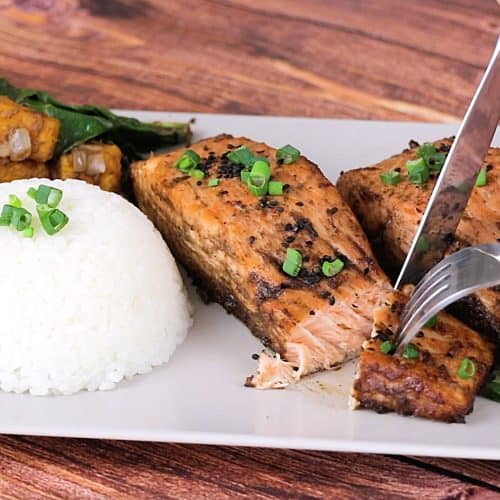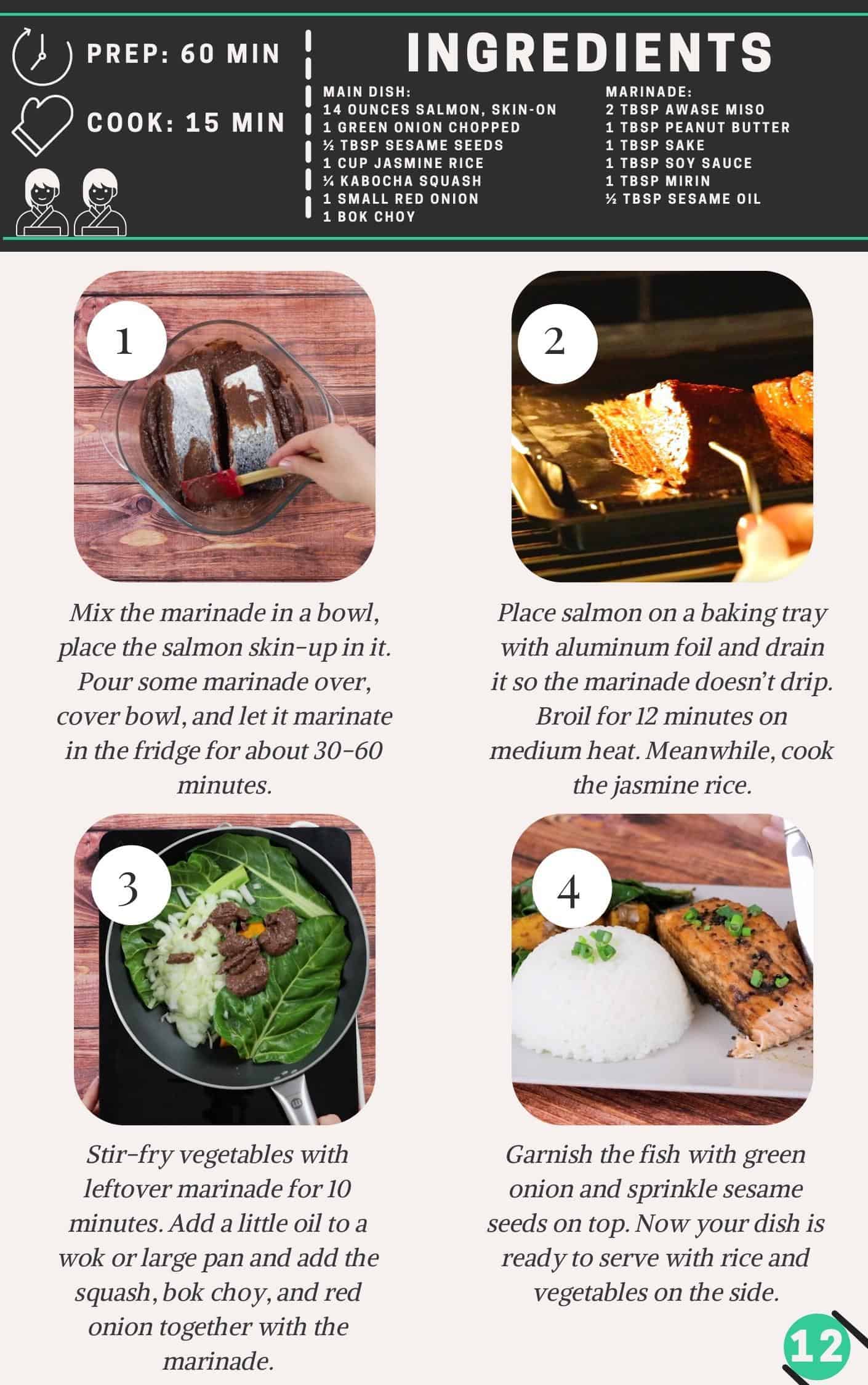A delicious & easy miso glazed salmon recipe everyone will love
Salmon marinated in a flavorful mixture of miso, soy, and sake, then oven-broiled. Sounds delicious, right?
If you are a fan of Japanese flavors, you’ll love this quick and easy recipe. You only need fresh salmon filets and just a few ingredients to make this dish.
It’s perfect for a light weeknight dinner, and it pairs well with aromatic jasmine rice or grilled veggies, so what are we waiting for?


Check out our new cookbook
Bitemybun's family recipes with complete meal planner and recipe guide.
Try it out for free with Kindle Unlimited:
Read for freeIn this post we'll cover:
Oven broiled miso-glazed salmon


Oven broiled miso glazed salmon with sushi rice and vegetables
Ingredients
- 14 ounces salmon with skin-on, cut the fish into two equal pieces
Marinade
- 2 tbsp awase miso a mix of white and red miso
- 1 tbsp peanut butter
- 1 tbsp sake
- 1 tbsp soy sauce
- 1 tbsp mirin (or sugar if you don't have any)
- ½ tbsp sesame oil
Toppings
- 1 green onion chopped
- ½ tbsp sesame seeds toasted
Pair the miso salmon with rice and vegetables
- 1 cup jasmine rice
- ¼ kabocha squash Cut into 1/2-inch- slices for easy grilling
- 1 small red onion
- 1 bok choy keep the leaves whole
Instructions
Preparing the Salmon
- Mix all your ingredients for the marinade in a large bowl.

- Take the salmon filet and place it in the marinade skin-up. With a spoon, pour some of the marinade over the fish and cover the bowl with plastic cling wrap.

- Place the bowl in the refrigerator and let it marinate for about 30-60 minutes.
- Next, prep your baking tray with aluminum foil and place your fish filet on top of it. Make sure to drain the salmon, so the marinade doesn’t drip.
- Broil the salmon for about 12 minutes on medium heat. Read the broiling recommendations below.
- Cook the jasmine rice according to instructions.
Broiling the Salmon
- Preheat the broiler oven.
- Place the cooking rack at about 15 centimeters / 6 inches from the top of the heating element.
- Broil the fish at medium heat (500 F or 260 celsius) for about 12 minutes or until the fish is browned on top.
- The cooking time may vary depending on how thick the salmon filets are.
- You can use a meat thermometer to check that the salmon’s internal temperature is 145 F or 63 degrees Celsius.

Using leftover marinade
- I like to stir-fry the vegetables with the leftover marinade in around 10 minutes. Add a little oil to a wok or large pan and add the squash, bok choy, and red onion together with the marinade. Some people prefer grilled veggies so you can do that too with just a little bit of oil and add the marinade afterward.

Serve
- Chop the green onion and garnish the fish. Sprinkle the sesame seeds on top.

- Now your dish is ready to serve on a plate with the salmon rice on the side and the vegetables with all the miso sauce next to it.

Video
Nutrition
Cooking tips
It’s best if you use an awase miso for this. It’s a mix of white and red miso in just the right amounts to give it a bit of a kick without overpowering your dishes. My favorite brand is Miko.


Here are the main differences between Jasmine and Basmati rice to get you started on the perfect rice for these Japanese dishes.
After the miso has marinated with the fish, you need to make sure the salmon isn’t drenched in the marinade before you put it on your baking tray, or else it will burn easily.
You want to avoid the burnt miso flavor in your food!
The goal is to have a light glaze on the salmon, which you can achieve by brushing a small quantity of marinade on top of the filet.
When you broil the fish in the oven, the glaze will caramelize and intensify the delicious flavors.
Note: You can store the fish in the fridge during the day. It has to marinade at least 30-60 minutes to get the best flavor, but you can do this as soon as you get home from work or do it in the morning before you leave. Cooking the dish doesn’t take that long but it will be much tastier if you let the fish marinate for a bit.

Broiling Salmon
You can choose to bake the salmon in the oven, but I recommend you broil it in the oven instead.
If you have an electric oven, it’s very easy to broil. Just place the fish on the top rack close to the infrared heating energy.
Broiling accelerates the cooking process and gives your salmon a brown coating.
The key to successful broiling is not about setting the perfect temperature in the oven.
Instead, you must maintain the right distance between the food and the heating element at the top of your oven.
Alternative Cooking Method: Baking the Salmon
If you can’t broil the salmon filet, you can bake it in the oven, and it tastes almost the same.
To bake, preheat the oven to 425 F/ 218 Celsius.
Place the fish on the baking tray and place the tray in the middle rack of the oven.
Let the salmon bake for about 10-13 minutes, depending on the thickness of the filets.
Looking for more recipes with delicious salmon? Check these 5 Best Teppanyaki Salmon Recipes to try out this week.
Miso in Japanese cuisine
In many Japanese recipes, miso is often paired with seafood.
In case you’re unfamiliar with miso, it is a fermented soybean paste made with a fermentation starter called koji and left to ferment for months.
It’s used as a flavoring condiment in many of Japan’s most popular dishes. You’ve probably heard of miso soup already because it’s a healthy dish.
Miso is full of vitamins, minerals, and it’s great for gut health.
So, what does it taste like?
Well, it’s salty and savory, and when you use it as a marinade for salmon, it tastes best if you mix it with something sweet like honey or mirin.
If you’re out of mirin, you can also use a bit of sugar as a sweetener.
Read more about the amazing world of miso: What are the different types of miso? [full guide to miso]
Nutritional Information
Salmon is a healthy fish because it is a source of omega-3 fatty acids.
These healthy fatty acids help reduce inflammation in the body and improve your metabolism’s fat-burning capacity. Thus, it can help you lose weight.
Salmon is also known to help regulate blood pressure and blood sugar.
A 4-ounce piece of sockeye salmon contains approximately 16-170 calories, of which about 70 calories come from fat.
As well, salmon contains about 26 grams of protein and 75 mg of cholesterol.
1 ounce of miso has about 56 calories. As well, it has 7 grams of carbohydrates and 2 grams of fat. It’s also a good source of vitamin B, vitamin K, and copper.
It is healthy because miso is a fermented food that aids digestion and is full of good gut bacteria. Since miso is a fermented food, the body can absorb the nutrients more efficiently.
However, it’s essential to keep in mind that miso is very salty, so it has a high sodium content.
People with diabetes or heart disease should be very careful about eating miso.
Pairing the fish
If you love seafood and salmon, you can make this easy dish for lunch and dinner alongside a serving of jasmine or basmati rice.
Rice pairs well with salmon because it has a subtle taste and doesn’t overpower the fishy flavor.
Jasmine rice is lightly aromatic, so it adds extra richness.
The best part about this recipe is that it’s quick and simple to make, and you don’t need many ingredients.
Now your ready to enjoy this delicious piece of fish!
Be sure to add the bok choy last so it’s still crunchy when you bite into it.
If you love the taste of miso, you should try this easy 20 minute miso soup as well
We’ll make a vegan cold brew dashi from scratch, it’s the easiest way to make dashi if you’ve never tried it before.
Check out our new cookbook
Bitemybun's family recipes with complete meal planner and recipe guide.
Try it out for free with Kindle Unlimited:
Read for freeJoost Nusselder, the founder of Bite My Bun is a content marketer, dad and loves trying out new food with Japanese food at the heart of his passion, and together with his team he's been creating in-depth blog articles since 2016 to help loyal readers with recipes and cooking tips.
